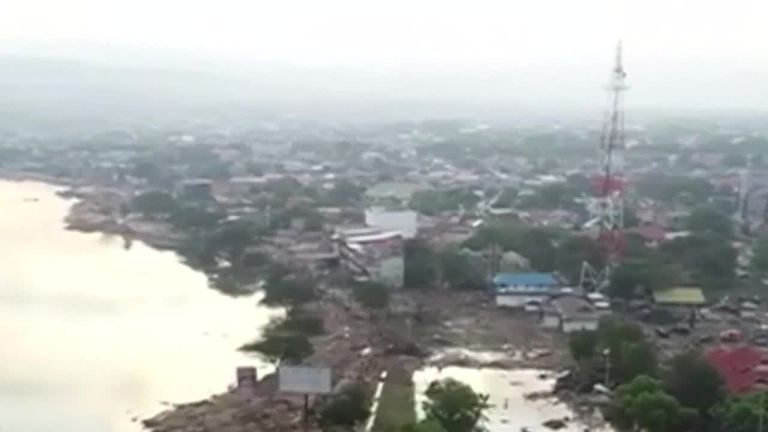More than 400 people killed after earthquake triggers tsunami in Indonesia
Waves of up to two metres high swept through the city of Palu on Sulawesi island after the聽quake brought down several buildings.
Sunday 30 September 2018 07:29, UK
More than 400 people have been killed after an earthquake and tsunami struck Indonesia.
The figure comes from one city - Palu - where hundreds of people are injured and thousands of homes have been damaged or destroyed, a spokesman for the disaster mitigation agency confirmed.
At least 540 people were badly injured and 10,000 people are estimated to be in shelters across the city, he added.
Aerial images have shown the scale of destruction left in the aftermath of the deadly tsunami in Palu.
Waves up to six metres (20ft) high swept onto the island of Sulawesi after the magnitude 7.5 quake brought down several buildings and sent people fleeing from their homes when it struck at a depth of six miles (10km) just before 11am GMT - early evening in Indonesia on Friday.
The number of people who have died is expected to rise sharply on Sunday as news arrives from remote areas.
About 60 people are trapped in the rubble of Palu's Roa-Roa Hotel, which was completely flattened by the quake, killing one guest.
Many of those killed were at a beach festival in Palu, the capital of Central Sulawesi province, which was strewn with debris from collapsed buildings and pooled seawater.
Hundreds who were attending the festival are unaccounted for, the national disaster agency said.
Terrified locals slept outside on Saturday night, fearing powerful aftershocks would topple damaged homes.
"When the (tsunami) threat arose yesterday, people were still doing their activities on the beach and did not immediately run and they became victims," disaster agency official Sutopo Purwo Nugroho said.
"The tsunami didn't come by itself, it dragged cars, logs, houses, it hit everything on land," he added.
Palu - which has a population of more than 380,000 - is built around a narrow bay which apparently magnified the force of the tsunami water as it raced into the tight inlet.
A magnitude 6.1 earthquake which earlier hit central Sulawesi also reportedly killed one person and injured 10 others, as well as damaging dozens of houses.
More than half of Palu prison's 560 inmates escaped after its walls collapsed, state news agency Antara said.
"It was very hard for the guards to stop the inmates from running away as they were so panicked and had to save themselves too," Antara quoted warden Adhi Yan Ricoh as saying.
"We haven't even have time yet to report this incident to our superiors."
Authorities are struggling to co-ordinate the rescue effort because a power outage has cut communications around Palu and the nearby town of Donggala, which is closest to the epicentre of the quake.
The military has sent cargo planes with aid from Jakarta and other cities, but evacuees still badly need food and other basic necessities.
Palu's airport was reopened only for relief efforts and would remain closed until 4 October for commercial flights as they attempt to repair the runway and air traffic control tower which were damaged in the quake, authorities said.
Hospitals have been overwhelmed by the influx of injured, with many people being treated outside.
Partially covered bodies were seen lying on the ground near the shore.
Officials said some victims had been trapped in the rubble of collapsed buildings.
Mr Nugroho said: "Bodies of victims were found in several places, because they were hit by the rubble of collapsing buildings or swept by tsunami... but we are still collecting data."
Indonesian president Joko Widodo said the military was being called into the disaster-struck region to help search-and-rescue teams reach victims.
United Nations spokesman Stephane Dujarric said UN officials were in contact with Indonesian authorities and "stand ready to provide support as required".
The earthquake hit at a depth of 10km (6.2 miles) just before 6pm local time (12pm UK time) on Friday, the US Geological Survey said.
A tsunami warning was issued but lifted within the hour.
Footage posted online showed waves of water bring down several buildings and swamp a large mosque in Palu.
"I just ran when I saw the waves hitting homes on the coastline," said Palu resident Rusidanto.
"We all panicked and ran out of the house" when the quake hit, said Anser Bachmid, a 39-year-old Palu resident.
"People here need aid - food, drink, clean water. We don't know what to eat for dinner tonight."
In the city of Donggala, north of Palu and home to nearly 300,000 people, a large bridge with yellow arches that spanned a coastal river collapsed.
At least one person was reported dead but with communication cut of there were fears many more could have died.
The 7.5 magnitude tremor later on was more powerful than a series of quakes that killed more than 550 people on the Indonesian holiday island of Lombok in July and August.
Indonesia is prone to earthquakes because of its location on the Ring Of Fire, an arc of volcanoes and fault lines in the Pacific Basin.
On Boxing Day in 2004, a massive 9.1 magnitude earthquake off Sumatra in western Indonesia triggered a tsunami that killed 230,000 people in a dozen countries across the region, including 168,000 in Indonesia.














